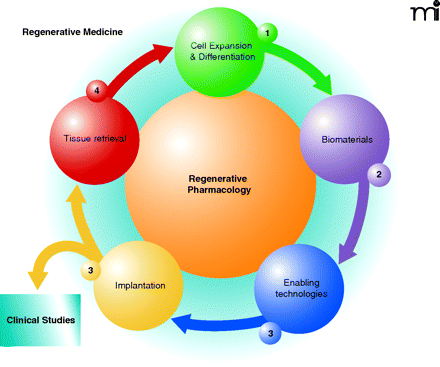
- Institution: Stanford Univ Med Ctr Lane Med Lib/Periodical Dept/Rm L109
- Sign In as Member / Individual
REGENERATIVE PHARMACOLOGY: THE FUTURE IS NOW

The central role of pharmacology in regenerative medicine and tissue engineering.Regenerative pharmacology would provide both a screening and optimization tool for accelerated maturation and function of bioengineered tissues. 1. Cell expansion and Differentiation signifies cell expansion and differentiation via modulation/manipulation of growth factors, cytokines, hormones, neurotransmitters and neuromodulators-both before and after scaffold seeding. 2. Biomaterials involve the use of biodegradable, biocompatible, cell and tissue-specific scaffolds to modulate cellular phenotype/pharmacology and promote cellular integration and tissue formation in vitro and in vivo. 3. Enabling Technologies will use nanotechnology in the development of “smart” scaffolds for sustained or burst release of drugs, hormones, chemicals, growth factors. Bioreactors are center-stage for tissue preconditioning and optimization of cellular phenotype, tissue organization, maturation and function, as is the development of non-invasive pharmacological evaluation of engineered tissues. Thus, it is clear that enabling technologies will be required throughout the tissue engineering process. However, we illustrate its contribution at this point in the process to emphasize the importance of this particular step to mainstream pharmacology (see Table 1). 4. Implantation includes the functional evaluation of engineered tissues. Again, drug and cell delivery technologies can be utilized to further accelerate and enhance tissue maturation, integration, and function. VEGF, NGF, for example, may be provided via encapsulation techniques to promote accelerated in growth of vessels and nerves, respectively, into the engineered tissue. 5. Tissue biopsy involves the pharmacological characterization of cell phenotype and tissue function. Again, during the preclinical development phase of the tissue engineering process, one would assess membrane receptors, signal transduction, excitation-contraction coupling. This information is then used to evaluate the existing protocol and thereby direct optimization of the tissue engineering process.


